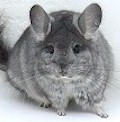Chinchillas are very unique creatures that are only found in the Andes Mountains (originally). Because of the unique environment they were made for, they require special care to be sure that they live long, healthy lives. It's true that the cage you buy probably won't be exactly like the Andes Mountains where your chin is originally from, but with a little planning and forethought, you can get it as close as possible. Here are some steps for you to make your chin feel at home by mimicking the natural chinchilla habitat.
The first thing you should worry about matching is the landscape. The mountainside where they are from is steep and rocky, giving them lots of stuff to jump and climb around on. To imitate this, you should look for a cage that is nice and tall with ramps and shelves that your chin can climb. An exercise wheel is another thing that is almost essential to keep your chin well-exercised. One rule with buying a cage is the bigger the better!
Along with a big cage, chinchillas need plenty of exercise. The tall cage will definitely help with this, but even better is to let them out of their cage at least once a day to run around a closed room that you have "chilla proofed." Keep an eye on him at all times when he's running around the room, and don't let him get ahold of any wires or other dangerous things. Chins have a tendency to chew on stuff, so be sure you watch him around your furniture!
Another very important aspect of their natural habitat is the temperature. They are made with thick fur coats to stay warm in the cold mountains. So when you take them and put them in your house in a warm room, they can easily overheat because they have no way to cool themselves (i.e. they don't sweat). So it's very important that you have at least one room in your house that ALWAYS stays at 70 degrees F or lower. Too long at 75 degrees F can make them overheat, and anything above 80 can give your little guy heatstroke.
Back in the Andes, chinchillas will roll around in piles of volcanic rock dust or ash to stay clean. I know this may sound counter-intuitive, but it's true! The fine dust actually gets into their thick fur and absorbs any excess moisture, oils, and dirt to keep them clean and healthy (although a bit dusty). To imitate this you will need to buy specially made chinchilla dust that he can roll around in. Find a container that won't tip over, put some dust in, then put your chinchilla in and he will have a fun time rolling around and getting clean.
Since your chin won't have the opportunity to roam around and chew on various things to keep his teeth filed down (like he would in his natural habitat) it's important to provide him with chewing blocks. Never put anything plastic in their cage, because they will chew it up an ingest it, which can make them sick or even kill them.
One area where you won't want to match the natural chinchilla habitat is in their diet. Wild chins can eat plants, fruit, seeds, and insects, but a diet like that will irritate your domestic chinchillas' digestive system. Instead you should feed him mostly special chinchilla pellets, with some hay mixed in there for fiber. Treats are OK once in a while too.
If you keep all this in mind when setting up your chinchilla habitat, you´re sure to have a happy, healthy chinchilla for manyyears to come!
